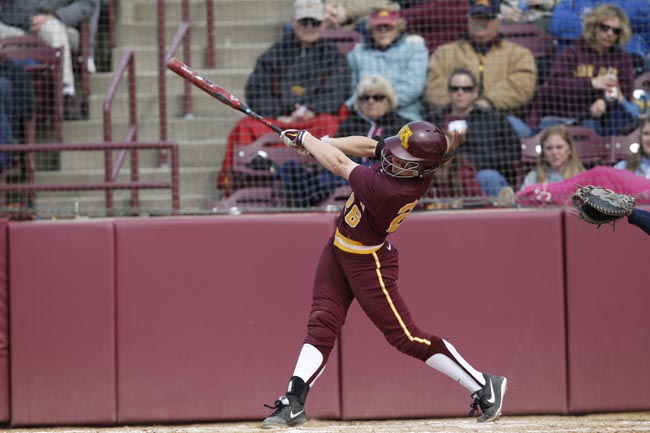
Kaitlyn Richardson is a senior at Minnesota’s Carlson School of Management. She is an Academic All-Big Ten and NFCA All-America Scholar Athlete. She has also received Minnesota’s Patty Berg Legacy Award for excellence in competition and in the classroom while representing the values of the athletics department. Photo courtesy of Minnesota Athletics
Wake up at 5:30 a.m. for a weight-training workout an hour later. Workout until 8:00, then go to class from 8:30 to 11:30. Take a break for lunch and homework and then report to practice at 2:00 p.m. Practice is actually at 3:00 but your coach has emphasized the need to put in extra work on your own. At 6:00 p.m., when your classmates are sitting in the dining hall, you have a group project meeting. Then you spend the remainder of the evening studying and working on the rest of your homework. It often lasts until midnight or later. Then, you wake up and start the process over.
This is the life of a student athlete at a top business school. Many private schools provide top-notch education but do not compete with the athletic budgets at larger public institutions. Many of those large public institutions might provide state-of-the-art athletic facilities, but not the equivalent business education. Some schools, however, have found the sweet spot between the two. And the student athletes deciding to attend those schools might be onto something.
Gone are the days when athletes coasted through college. Athletes are increasingly expected to maintain passing grades and graduate. And they less likely to do it while majoring in “general studies.” What’s more, employers are beginning to take notice.
COMPETITIVE ON AND OFF THE FIELD
It goes without saying that athletes are driven and competitive—both attractive qualities, especially to companies hiring for salespeople and other business-related positions. But now universities are making sure, more than ever, that their students are capable off the field.
Follett Carter is a sales professor at Michigan’s Ross School of Business and has seen many athletes pass through his classes. Carter says Ross attracts all kinds of athletes, and Ross students are hard working and intelligent regardless of athletic prowess. But the defining quality of a student athlete is the confidence exuded.
“In the old days, they (student athletes) would take the easiest courses available,” Carter says. “I see a lot less of that now. That has really gone down. Ross is such a demanding program. The athletes who are here are doing two jobs. The kids that come here are looking at life beyond football or track.”
Actually, student athletes are graduating at a rate of 82%, which happens to be higher than college students in general. Moreover, 20% of student athletes are first-generation college students. Across the three divisions of the National Collegiate Athletic Association (NCAA), there are more than 460,000 student athletes. Only 2% compete professionally. The vast majority will be looking outside athletics. And a few b-schools provide an alternative option with a blue chip education and access to top notch athletics.
ROSS AND CARLSON BOAST TOP-NOTCH ATHLETES
The University of Minnesota’s Carlson School of Management is another program that has many athletically gifted and intelligent student athletes. The school currently has 65 athletes enrolled and academic advisor Lindsay Gundecha knows them all. Gundecha meets with each one at least once a semester during their time at Carlson. She says the ability that these student athletes have in balancing academics, athletics and a social life with such positive attitudes is inspiring.
“I am truly impressed with how my student athletes react when faced with a challenge, injury or setback,” Gundecha says. “The resiliency and maturity I have witnessed during these times in their lives have left a lasting impact on me.”
The athletic talent at Carlson is impressive. Andre Hollins is one of the best guards in the nation and spent last season starting on Minnesota’s basketball team. Sophomore Lee Stecklein was the youngest member ever on the U.S. Women’s silver medal hockey team. Senior Kaitlyn Richardson is an All-American softball player. Despite all of them having professional sports aspirations, they all plan on using their Carlson degrees.
And to get the most out of those degrees, the athletes, like the other students, are expected to complete group assignments, do internships, and complete Carlson’s mandatory international study component. Sometimes it takes a little creativity from advisors, students, and coaches to schedule appropriately.











Questions about this article? Email us or leave a comment below.